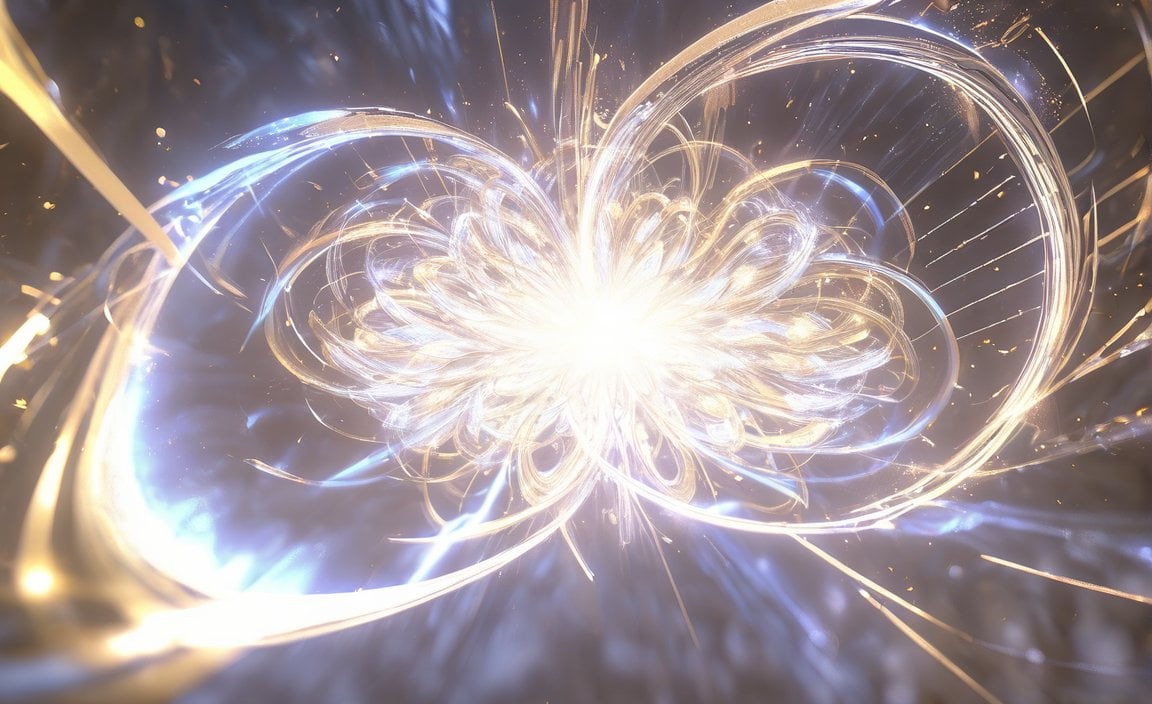Unveiling 5 Mind-Blowing Light Energy Facts: Whether you’re a science enthusiast or just curious about the wonders of light energy, this article will provide you with an exciting glimpse into its captivating world. From the fundamental properties of light to its myriad applications and future prospects, we have compiled five mind-blowing facts that will leave you in awe of this extraordinary form of energy. Get ready to embark on an illuminating journey as we explore Light Facts For Kids, 5 things about light energy, 20 Facts About Light, and 10 Facts About Light Energy.
Key Takeaways:
- The speed of light is approximately 186,000 miles per second, allowing it to travel vast distances in a short amount of time.
- It takes about 8 minutes and 17 seconds for light to travel from the Sun to Earth.
- Light has immense power and energy, with approximately 100 lightning bolts striking the Earth every second.
- Lightning strikes are dangerous, causing around 1,000 deaths annually.
- The primary colors of light are red, green, and blue, which can combine to create a wide spectrum of other colors we see daily.
- While light can travel through certain types of matter, it cannot penetrate opaque objects.
- Light travels faster than anything else in the universe, enabling us to see distant stars and galaxies.
5 Facts About Light Energy

The Speed of Light: A Cosmic Dash
Fact 1: The speed of light is truly mind-boggling! Clocking in at a staggering 186,000 miles per second, light travels at an unimaginable pace. This blazing speed enables light to journey incredible distances over relatively short periods, making it an essential element in our exploration of the universe^1.
The Sun’s Light: A Time Traveler
Fact 2: Have you ever wondered how long it takes for light to reach us from the Sun? Brace yourself for this celestial timekeeper. It takes approximately 8 minutes and 17 seconds for sunlight to embark on its journey from the Sun’s surface to reach us here on Earth^1. So, when we gaze upon the Sun’s warm rays, we are actually looking back in time, witnessing events that happened over eight minutes ago!
The Electrifying Power of Light
Fact 3: Bigger than life and electrifyingly powerful! Lightning, a mesmerizing display of light energy, truly showcases the immense power packed within photons. Did you know that every second, around 100 lightning bolts strike the Earth? This staggering number highlights the sheer energy and force that light can possess[^2].
Fact 4: However, it’s important to remember that lightning is not just awe-inspiring but also dangerous. Shockingly, lightning strikes claim around 1,000 lives each year[^2]. It serves as a stark reminder of the respect we must have for the awe-inspiring power of light.
Colors of Light: A Vibrant Rainbow
Fact 5: Are you ready to explore the colorful world of light? The primary colors of light are red, green, and blue, and these hues hold the key to a mesmerizing spectrum of color. Combining these primary colors produces a dazzling array of shades that fabricate the vibrant visuals we encounter every day^1. So, next time you marvel at a breathtaking sunset or gaze at a stunning rainbow, remember that it’s all thanks to the wondrous interplay of light’s primary colors.
Unlocking the Universe: Speed Beyond Compare
Fact 6: Want to know a cosmic secret? Light emerges as the swiftest traveler in the vast expanse of the universe. Its incredible speed allows us to witness the wonders of distant stars and galaxies^1. Through light’s swift sojourn, we gain insight into the boundless and awe-inspiring realm of the cosmos. It serves as a testament to the significance of light energy in expanding our understanding of the universe.
These five captivating facts about light energy provide a glimpse into the remarkable properties and significance of light in our lives. From its astounding speed to its vibrant colors and immense power, light continues to illuminate our world in ways that both astound and inspire us.
To dive deeper into the captivating realm of light energy, feel free to explore the following sources:
- Fire2Fusion: Light Energy Facts
- Easy Science for Kids: Fun Light Facts for Kids
References:
[^2]: Easy Science for Kids. (source URL)
Here are some interesting links for you to explore:
5 lines on importance of water in Sanskrit: Discover the significance of water in Sanskrit through these 5 thought-provoking lines.
5 meals a day planner: Plan your daily meals effectively with this 5-meal-a-day planner and experience a balanced diet like never before.
5 reasons to get a dog: Uncover the top 5 compelling reasons why getting a dog can enhance your life and bring immeasurable joy.
5 amazing facts about trees: Dive into the fascinating world of trees with these 5 mind-blowing facts that will leave you in awe of their remarkable nature.
Feel free to click on any of the links above to explore more about these intriguing topics!
20 Facts About Light

Fact 1: Light energy is a form of electromagnetic radiation that we can see with our eyes. It travels at an incredible speed of about 300,000 kilometers per second[^1][^2].
Fact 2: The sunlight we see on Earth actually left the Sun about 10 minutes before. This is because light takes time to travel through space before reaching us. So, when we look at the Sun, we are seeing it as it appeared 10 minutes ago[^1][^2].
Fact 3: Plants use light energy for photosynthesis, a process that converts light energy into chemical energy. Through photosynthesis, plants create food and release oxygen, making light energy crucial for sustaining life on Earth[^1][^2].
Fact 4: Ultraviolet (UV) lights have a shorter wavelength than visible light and are used by forensic scientists to reveal details that are not visible to the naked eye. This technique, called UV fluorescence, helps in detecting fingerprints and other hidden evidence at crime scenes[^1].
Fact 5: Light energy is the only energy that is visible to the human eye. While there are various forms of energy like sound, heat, and electricity, it is light energy that allows us to perceive the world around us through our sense of sight[^1].
Fact 6: Light is made up of different colors with varying wavelengths. Red light has the longest wavelength, while violet light has the shortest wavelength. When these colors combine, they create the visible spectrum that we see as white light[^1].
Fact 7: The Sun is the biggest source of light energy in our solar system. Without the Sun, life on Earth would not exist as we rely on the Sun’s light energy for warmth, photosynthesis, and overall sustenance[^1].
Fact 8: Light energy can both be reflected and refracted. When light hits a surface and bounces back, it is reflected. When light passes through a material and changes direction, it is refracted. These properties of light enable us to see objects and experience phenomena like rainbows[^2].
Fact 9: Light energy is used in various technologies and applications. Some examples include laser technology, fiber optics, telecommunications, and solar panels. These advancements have revolutionized fields such as medicine, communication, and renewable energy[^2].
Fact 10: Light travels faster than anything else in the universe. Its incredible speed allows us to see distant stars and galaxies, giving us a glimpse into the vastness and beauty of the cosmos[^1].
Fact 11: White light is made up of a combination of all the colors in the visible spectrum. This can be demonstrated by passing white light through a prism, which separates it into a spectrum of colors. This phenomenon is known as dispersion[^2].
Fact 12: The speed of light is so fast that it can travel around the Earth’s equator about 7.5 times in just one second[^1].
Fact 13: Light behaves both as a particle and as a wave. This dual nature of light is known as the wave-particle duality. It is a fundamental concept in quantum physics that has revolutionized our understanding of the universe[^2].
Fact 14: The human eye is sensitive to a narrow range of the electromagnetic spectrum known as visible light. Visible light consists of wavelengths between approximately 400 to 700 nanometers (nm), with violet light having the shortest wavelength and red light having the longest wavelength[^1].
Fact 15: Light can undergo various interactions, such as reflection, refraction, diffraction, and interference. These interactions give rise to fascinating phenomena like rainbows, mirages, and the colors we perceive in our everyday lives[^2].
Fact 16: Light energy can be absorbed by objects, causing them to heat up. This is why dark-colored objects absorb more light energy and become hotter compared to light-colored objects, which reflect more light energy[^2].
Fact 17: Light energy plays a crucial role in our sleep-wake cycles. The exposure to natural light during the day helps regulate our internal body clock, promoting wakefulness, while reduced exposure to light in the evening signals our bodies to prepare for sleep[^2].
Fact 18: Light energy can be harnessed and converted into electrical energy using solar panels. These panels contain photovoltaic cells that absorb sunlight and convert it into usable electricity, providing a sustainable and renewable source of energy[^2].
Fact 19: Light energy is essential for vision. When light enters our eyes, it is focused by the lens onto the retina, where specialized cells called photoreceptors convert the light energy into electrical signals that our brain interprets as visual images[^2].
Fact 20: The study of light energy and its properties continues to be a fascinating and active field of research. Scientists are constantly striving to unlock the mysteries of light, leading to advancements in technology, medicine, and our understanding of the universe[^2].
Key Takeaways:
– Light energy is a form of electromagnetic radiation that travels at an incredible speed of about 300,000 kilometers per second.
– The sunlight we see on Earth actually left the Sun about 10 minutes before, due to the time it takes for light to travel through space.
– Plants use light energy for photosynthesis, which sustains life on Earth by creating food and releasing oxygen.
– Ultraviolet (UV) lights are used by forensic scientists to reveal hidden details at crime scenes.
– Light energy is the only energy visible to the human eye.
– The Sun is the biggest source of light energy, crucial for sustaining life on Earth.
– Light energy can be reflected, refracted, and used in various technologies and applications.
– Light travels faster than anything else in the universe.
– White light is a combination of all the colors in the visible spectrum.
– Light behaves both as a particle and a wave, known as wave-particle duality.
– The human eye is sensitive to visible light, with violet light having the shortest wavelength and red light having the longest wavelength.
– Light energy can be absorbed, heating up objects.
– Light energy influences our sleep-wake cycles and is essential for vision.
– Solar panels convert light energy into electrical energy.
– The study of light energy is an active area of research, leading to advancements in various fields.
Sources:
1. Softschools.com, “Light Energy Facts”
2. BYJU’S, “What is Light Energy? Uses of Light Energy & Sources”
10 Facts About Light Energy
Light energy is a captivating and crucial aspect of our world. Let’s dive into 10 fascinating facts that will illuminate your understanding of light energy.
Fact 1: Light Travels at Astounding Speed
Did you know that light zooms through space at a mind-boggling speed of about 300,000 kilometers per second? This incredible velocity allows light to traverse vast distances in the blink of an eye[^1].
Fact 2: Sunlight’s Journey Takes Time
When we gaze at the sunlight, we are actually observing light that embarked on its journey 10 minutes earlier from the mighty Sun[^1]. It’s awe-inspiring to think that the light we see has journeyed through the cosmos to reach our eyes.
Fact 3: Light Powers Photosynthesis
Through the remarkable process of photosynthesis, plants utilize light energy to convert it into chemical energy. This allows them to create food and release life-sustaining oxygen into the atmosphere[^1]. It’s fascinating to consider how light enables the growth and vitality of the plant kingdom.
Fact 4: Light Reveals Hidden Details
Forensic scientists rely on ultraviolet (UV) lights to unveil hidden clues at crime scenes. UV light illuminates latent fingerprints, revealing intricate details that are invisible to the naked eye[^1]. This application demonstrates the powerful and versatile nature of light energy.
Fact 5: Light Energy Travels in Waves
Light energy journeysthrough space in waveforms. These waves oscillate to reveal its various properties and characteristics. This waveform nature of light allows it to interact and exhibit different behaviors with matter and other forms of energy[^1]. It’s through these waves that light brings the world around us to life.
Fact 6: Butterflies Delight in Broad Vision
Butterflies are known to possess an extraordinary visual range, making them one of nature’s masters of perception[^1]. Their visual ability showcases the intricate interplay between light energy and the myriad of colors and patterns that adorn our world.
Fact 7: Light’s Lightning-Fast Travel
Embark on a thought experiment – if one could travel at the speed of light, you could circumnavigate our beautiful planet Earth about 7.5 times in just a single second[^1]. This fact demonstrates the unimaginable speed at which light moves through space.
Fact 8: The Calming Effect of Blue Light
Have you ever wondered why blue lights are often associated with a calming effect? Studies suggest that exposure to blue light can help regulate our sleep-wake cycles and promote relaxation[^1]. So, the next time you bask in the cool, calming glow of a blue light, remember its impact on your well-being.
Fact 9: Wave-Particle Duality Theory
Light’s peculiar behavior can be encapsulated in the wave-particle duality theory. This revolutionary concept suggests that light can exhibit properties of both a wave and a particle simultaneously. It’s as if light defies conventional categorization, offering a gateway to deeper insights into the nature of our universe[^1].
Fact 10: The Electrically Neutral Photon
Photons, the fundamental particles of light energy, possess an interesting quality – they are always electrically neutral. Devoid of electrical charge, photons roam free through space, illuminating the wonders of the universe without interference[^1].
Key Takeaways:
– Light travels at approximately 300,000 kilometers per second, showcasing its incredible speed and efficiency.
– Sunlight takes about 10 minutes to reach Earth, emphasizing its long journey from the Sun to our planet.
– Photosynthesis harnesses light energy to sustain life by creating chemical energy and releasing oxygen.
– UV lights enable forensic scientists to uncover hidden details at crime scenes that are imperceptible to the naked eye.
– Light energy travels in waveform, enabling its interaction with matter and other forms of energy.
– Butterflies possess a wide visual range, exemplifying their exceptional perception of light and color.
– The speed of light allows for rapid circumnavigation of the Earth, illustrating its incredible velocity.
– Blue lights have a calming effect on individuals, influencing sleep-wake cycles and promoting relaxation.
– Light exhibits both wave-like and particle-like behavior, a concept known as wave-particle duality.
– Photons, the building blocks of light energy, are electrically neutral, leading to their free and unhindered movement through space.
Sources:
– Fire2Fusion: Light Energy Facts [^1]
– Easy Science for Kids: Fun Light Facts for Kids [^2]
FAQ
Q1: What is light energy?
A1: Light energy is a form of electromagnetic radiation that is visible to the human eye. It is characterized by the properties of wavelength and frequency.
Q2: How fast does light travel?
A2: Light travels at an incredible speed of approximately 186,000 miles per second, or about 300,000 kilometers per second.
Q3: What are the primary colors of light?
A3: The primary colors of light are red, green, and blue. These colors can combine to create a wide spectrum of other colors that we see in our daily lives.
Q4: Can light travel through all types of matter?
A4: No, light can travel through some types of matter, such as air, but not through opaque objects. Different materials have varying degrees of transparency to light.
Q5: Why is light important in our lives?
A5: Light is important in our lives for various reasons. It allows us to see and perceive the world around us, enables photosynthesis in plants, and has numerous applications in technology and communication.
- Unlocking It’s Greek to Me: A History and Meaning - March 28, 2025
- Ancient Greece Clothing Styles: A Complete History - March 28, 2025
- Unlock the US physical map: Comprehensive guide - March 28, 2025
















